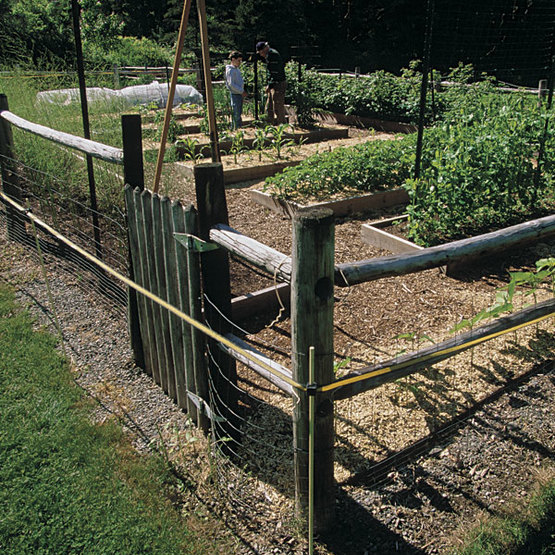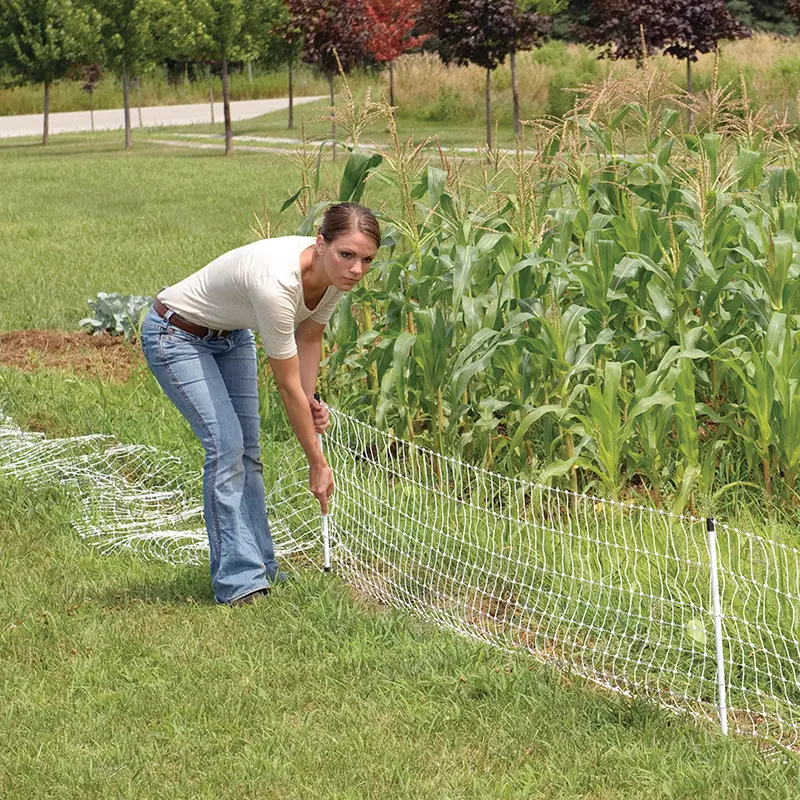Imagine stepping into your garden and finding it untouched by deer, rabbits, or other pesky critters. An electric fence for gardens could be your secret weapon to protect your precious plants and vegetables.
Have you ever felt the frustration of seeing your hard work and dedication being nibbled away overnight? You’re not alone, and there’s a simple solution that could save you both time and heartache. This isn’t just about keeping your garden safe; it’s about ensuring your peace of mind.
As you continue reading, you’ll discover how an electric fence can be a game-changer for your garden. You’ll learn about its benefits, how it works, and why it might just be the perfect fit for your gardening needs. Ready to find out how you can transform your garden into a safe haven for your plants? Let’s dive in!
JUMP TO TOPIC
Benefits Of Electric Fences
Electric fences offer many advantages for garden enthusiasts. They create a secure boundary and prevent wildlife from invading the garden. These fences are also a cost-effective solution for maintaining garden safety. Let’s explore the benefits of electric fences and how they can enhance your garden.
Enhanced Security For Gardens
Electric fences provide a reliable barrier for gardens. They protect plants from unwanted visitors. These fences deter human intruders effectively. The electric current acts as a strong deterrent, keeping your garden safe.
The fence is visible and acts as a warning. It signals that the area is protected. This visual cue enhances security without being aggressive.
Deterrence Against Wildlife
Wild animals often damage gardens. Electric fences prevent this by creating a physical barrier. They keep deer, rabbits, and other wildlife away. The mild electric shock discourages animals from crossing.
Gardeners can rest easy knowing their plants are safe. Electric fences ensure that wildlife stays out, maintaining the beauty of your garden.
Cost-effectiveness
Electric fences are affordable compared to other security options. Installation is straightforward and requires minimal upkeep. They offer long-term savings with their durability.
These fences use low power, making them energy-efficient. Gardeners can protect their plants without high costs. Electric fences are a smart investment for any garden.
Types Of Electric Fences
Garden electric fences come in various types, offering different levels of protection. Solar-powered fences are eco-friendly and efficient, while battery-operated options ensure consistent power. Wire-based fences provide a robust barrier, ideal for keeping pests away from your plants. Each type caters to specific garden needs, enhancing security and peace of mind.
Choosing the right type of electric fence for your garden can be a game-changer in protecting your plants from unwanted visitors. There are several types of electric fences available, each with its own advantages and drawbacks. Understanding these can help you make an informed decision that suits your garden’s needs perfectly.Temporary Vs Permanent Systems
Temporary electric fences are great if you need flexibility. They are easy to set up and remove, making them ideal for seasonal gardens or temporary protection. However, they may not be as sturdy or long-lasting as permanent systems. Permanent electric fences offer durability and are a solid investment for those who want a long-term solution. They require more effort and resources to install but provide consistent protection year-round. Which system fits your needs better?Solar-powered Options
Solar-powered electric fences are an eco-friendly choice. They harness the sun’s energy, reducing electricity costs and your carbon footprint. This option is especially beneficial in sunny areas where solar panels can be most effective. These systems can be a bit pricey upfront but consider the long-term savings. Imagine having a fence that guards your garden while also being gentle on the environment. Wouldn’t that be a win-win situation?Battery-powered Systems
Battery-powered electric fences offer portability and ease of use. They are perfect for gardens where access to electricity is limited. Plus, you can easily relocate the fence as needed without worrying about nearby power sources. One downside is the need to monitor battery levels regularly. But with the convenience they offer, battery-powered systems can be a great choice for small to medium-sized gardens. How important is mobility and ease of installation for your garden setup? Choosing the right electric fence type can significantly impact your garden’s safety and efficiency. Whether you opt for temporary or permanent, solar or battery-powered, the key is aligning the choice with your garden’s unique needs. So, which type of electric fence will you choose to keep your garden thriving?Installation Process
Installing an electric fence for gardens involves setting up posts and attaching wires around the garden’s perimeter. Connect the wires to a power source, ensuring they are at the right height to deter animals effectively. Regularly check the system to maintain its efficiency and safety.
Installing an electric fence in your garden can be a game-changer, offering protection against unwanted intrusions and safeguarding your plants. However, the success of your electric fence largely depends on its installation. Understanding the process is crucial to ensure the fence functions effectively and doesn’t become a hazard. Let’s break down the installation process into manageable steps.Selecting The Right Location
Choosing the right location for your electric fence is pivotal. Aim to position the fence where it can cover all vulnerable areas of your garden. Consider the landscape. Are there slopes or uneven terrain? These factors can affect how you install the fence posts. Think about accessibility too. You want the fence to be easy to access for maintenance but difficult for pests to breach. Reflect on where animals tend to enter your garden. Sometimes, observing their patterns can give you clues on the best spots to place your fence.Necessary Tools And Equipment
Having the right tools is essential for a smooth installation. You’ll need basic equipment such as a post-hole digger, wire cutters, and a voltmeter. Don’t forget the power source for the fence. This could be a solar panel or a battery. Gather all your materials beforehand. These include fence posts, insulators, and electrified wire. Think about the height and strength of the wire. Are you defending against rabbits or deer? The type of animal determines the specifications of the wire.Step-by-step Setup
1. Mark Your Territory: Start by outlining the area you wish to protect. Use stakes and string to visualize your fence’s path. This helps ensure you have enough materials and prevents miscalculations. 2. Install Fence Posts: Dig holes for your posts at regular intervals. Make sure they are sturdy and stable, as they will support the fence wire. Use a level to ensure they’re straight. 3. Attach Insulators: Once your posts are in place, attach insulators to keep the wire from touching the posts directly. This prevents grounding and maintains the electric current. 4. Run the Wire: Carefully thread the electrified wire through the insulators. Keep it taut but don’t overtighten, as this could cause it to snap. Check for any kinks or breaks. 5. Connect to Power: Attach the wire to your power source, whether solar or battery. Use a voltmeter to test the voltage and ensure the fence is functioning properly. 6. Test and Adjust: Walk along the fence and check for any weak spots or areas that need tightening. Adjust as necessary to ensure optimal performance. Does the idea of installing an electric fence sound daunting? Remember, every step you take is a step closer to a safer garden. With a bit of patience and attention to detail, your electric fence can become a reliable guardian for your plants. Are you ready to get started?
Credit: www.finegardening.com
Safety Considerations
Ensuring safety is crucial when using electric fences for gardens. Keep the voltage low to avoid harm to people and animals. Regularly check for damage or faults in the fence to prevent accidents.
### Safety Considerations Electric fences can be a practical solution for keeping animals out of your garden, but safety should always be a priority. You don’t want an unpleasant shock ruining the day for a neighbor, a pet, or even yourself. By taking a few thoughtful steps, you can ensure that your electric fence is safe and effective.Avoiding Harm To Humans And Pets
Ensuring the safety of your family and pets is crucial. Place clear warning signs around the perimeter of your garden. This alerts visitors to the presence of an electric fence and encourages them to keep a safe distance. Consider the height and voltage of the fence. A low-height fence is usually enough to deter small animals while reducing the risk to children and pets. Use a voltage that is effective but not overly strong, which can be both safe and functional.Regulatory Compliance
Before installing an electric fence, check local regulations. Some areas have specific laws regarding the installation and operation of electric fences. Talk to your neighbors about your plans. You might find they have valuable insights or concerns that you haven’t considered. This can prevent potential conflicts and ensure community harmony. Follow installation guidelines provided by the manufacturer. This ensures that your fence not only meets legal standards but also functions as intended.Proper Maintenance Practices
Regularly inspect your electric fence for wear and tear. Harsh weather conditions can damage the wiring or posts, leading to safety hazards. Keep the area around the fence clear of vegetation. Overgrown plants can short-circuit the fence, reducing its effectiveness and potentially causing safety risks. Test the voltage with a fence tester. This simple tool ensures that the fence is functioning correctly and safely, providing peace of mind.Safety should never be an afterthought when setting up an electric fence in your garden. How do you balance effectiveness with safety in your gardening practices? Adopting safe practices ensures that your garden is both protected and welcoming.
Maintaining Electric Fences
Caring for electric fences in gardens ensures plant protection. Regularly check for breaks or damage. Clear any vegetation touching wires.
Maintaining electric fences in gardens is crucial for their effectiveness. Proper maintenance ensures the fence works efficiently year-round. It helps keep unwanted animals out. Regular attention prevents costly repairs later. Let’s explore how to keep your electric fence in top shape.Regular Inspection Routines
Inspect your electric fence at least once a month. Check for broken wires or sagging sections. Look for signs of damage from weather or animals. Ensure insulators are intact and secure. Verify the power supply is consistent. An effective inspection routine prevents major issues.Troubleshooting Common Issues
Common fence issues include power loss or short circuits. Check the battery or power source regularly. Examine connections for corrosion or looseness. Use a voltage tester to ensure proper function. If power is weak, check for vegetation touching the wires. Troubleshooting early saves time and effort.Seasonal Adjustments
Seasons affect electric fence performance. In winter, check for ice or snow buildup. Adjust tension to prevent sagging from snow weight. In spring, inspect after storms or heavy rains. Summer heat may stress components, so check for overheating. Fall brings leaves; clear them from wires. Seasonal adjustments enhance fence longevity.
Credit: www.reddit.com
Environmental Impacts
Electric fences for gardens help protect plants without harming wildlife. They provide a safe barrier, deterring animals effectively. This environmentally friendly solution minimizes damage to ecosystems while safeguarding your garden.
Electric fences for gardens are becoming increasingly popular among eco-conscious gardeners. However, it’s essential to consider their environmental impacts. While they can protect your plants from unwanted intruders, they may also affect the local ecosystem. Understanding these impacts can help you make informed decisions that align with your commitment to sustainability.Effects On Local Wildlife
Electric fences can deter not just pests but also beneficial wildlife. Small animals like hedgehogs and birds might find their paths blocked, affecting their natural behaviors and habitats. Consider if your garden is a common route for local wildlife and how to minimize disruption. An unexpected insight from my garden was realizing that certain birds stopped visiting. I adjusted the fence height and left gaps for smaller creatures. Could simple adjustments improve your garden’s harmony with nature?Sustainable Practices
Building an electric fence sustainably means choosing eco-friendly materials. Opt for solar-powered units over battery-operated ones to reduce waste and energy consumption. Reusing materials for fence posts can also lessen your environmental footprint. Ask yourself if the fence materials align with your sustainability goals. Are there alternatives that might be more environmentally friendly?Reducing Carbon Footprint
Electric fences can be part of a larger strategy to reduce your garden’s carbon footprint. By using solar-powered fences, you tap into renewable energy sources. This choice cuts down on fossil fuel usage, which is crucial for protecting our planet. Consider how the energy source of your fence aligns with your carbon reduction goals. Is there a way to incorporate more renewable energy into your garden’s setup? Balancing garden protection with environmental care is no easy task. Yet, with thoughtful choices, you can enjoy a thriving garden that respects nature. What steps will you take to ensure your garden is both safe and sustainable?Cost Analysis
Understanding the cost of an electric fence is essential. You want a budget-friendly option. Let’s explore the different aspects of cost.
Initial Investment
The initial cost depends on several factors. It varies with the size of your garden. Basic setups are usually affordable. You might need a charger and fence posts. The cost of wires is also included. Prices can vary based on quality. Initial expenses might seem high, but they ensure a secure garden.
Long-term Savings
Electric fences offer long-term savings. Traditional fences need regular maintenance. Electric fences require less upkeep. This reduces future costs. They use minimal electricity. This keeps utility bills low. Longevity further adds to savings. The investment pays off over time.
Comparing With Traditional Fencing
Electric fences are often cheaper than traditional ones. Wooden or metal fences cost more. They require more materials and labor. Electric fences use fewer materials. Installation is also simpler. This can lower the overall cost. For many, electric options are more economical.

Credit: www.premier1supplies.com
Frequently Asked Questions
Will An Electric Fence Work For A Garden?
Yes, an electric fence can protect your garden from pests. It deters animals like deer and rabbits effectively. Ensure proper installation and maintenance for best results. Use a low-voltage fence for safety. Check local regulations before installation. An electric fence provides a cost-effective and eco-friendly solution for garden protection.
What Are The Disadvantages Of Electric Fence?
Electric fences may pose safety risks to children and pets. They require regular maintenance and can malfunction. Wildlife may be harmed, and installation costs can be high. Some people find them visually unappealing, impacting property aesthetics. Reliability depends on power availability, which can be disrupted by outages.
How To Set Up An Electric Fence For A Garden?
Install corner posts around the garden perimeter. Attach insulators to each post. Run electric wire through insulators. Connect the wire to an energizer. Ensure the energizer is grounded properly. Test the fence for proper voltage. Keep the area around the fence clear of vegetation.
Will An Electric Fence Keep Groundhogs Out Of The Garden?
Yes, an electric fence can deter groundhogs from entering your garden. Install it at the groundhog’s chest height for effectiveness. Regular maintenance ensures its efficiency.
Conclusion
Electric fences keep gardens safe from pests. They offer reliable protection. Easy to set up. Cost-effective in the long run. They are a smart choice for garden owners. No more worries about intruders. Enjoy peace of mind with a secure garden.
Simple maintenance keeps them working well. Protect plants and flowers effortlessly. Safe for humans and pets when installed correctly. Consider electric fencing for a better garden experience. Keep your garden flourishing and free from unwanted visitors. Embrace the benefits of electric fences today.
Protect your garden with confidence and ease.

